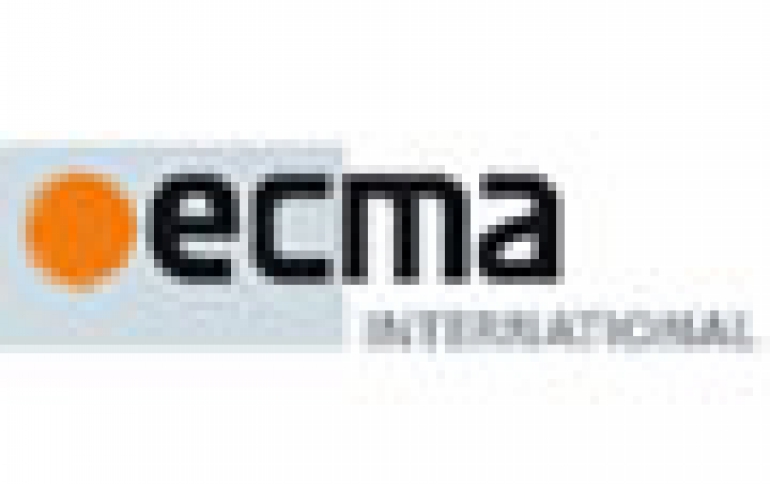
New ECMA Wireless Standard For Short-range Connectivity Operates At A Data Rate of 560 Mbps
Ecma International published a new wireless interface standard that enables fast data transfer by means of a simple "touch" between two devices in close proximity, the ECMA-398 - Close Proximity Electric Induction Wireless Communications.
This wireless standard enables a high-speed, bi-directional, point-to-point connection (4,48 GHz) for the transfer of large data between two active devices up to a few centimeters apart. This standard can be applied for a wide range of applications, regardless of product, usage model or content. From a user standpoint, the technology can be thought of as an intuitive, touch-activated, high-speed data interface providing instant connectivity and allowing immediate exchange of content between devices. Some use cases which can take advantage of this technology include the exchange of photos and videos between digital cameras and camcorders, downloading content from public signage onto smart phones, and streaming content in real time from mobile devices to audio visual playback systems.
The Ecma General Assembly approved this standard at its June 2011 meeting in Divonne, France. This standard is now submitted to ISO/IEC JTC 1 for approval.
Mr. Ko Togashi, Chair of Ecma TC50 said: "We are very happy that this technology has been adopted as an Ecma standard and is now publicly available for the realization of user-friendly and intuitive touch-based data transfer."
"This standard will change the way consumers handle and enjoy content by eliminating the complexity of traditional wireless connections, removable storage media and physical cables." said Mr. Kentaro Odaka, Chair of the TransferJet Consortium.
The new standard specifies a connection layer (CNL) and a physical layer (PHY) for transferring data between two close proximity entities using electric induction coupling. Implementations conforming to this Standard implement both the CNL and the PHY. All Conforming implementations support a centre frequency of 4,48 GHz.
The Standard specifies the bottom 2 layers of a close proximity wireless transfer technology. By touching (or bringing very close together) two electronic entities, this technology allows high speed exchange of data. The basic concept consists of a touch-activated multi-purpose interface designed for applications requiring high speed data transfer between two entities in a point-to-point (1:1) mode, without the need for external physical connectors.
The physical layer has a maximum transmission rate of 560 Mbps, adjusting the data rate downward according to the wireless environment to maintain a robust link even when the surrounding wireless condition fluctuates.
The RF transmit power is kept at a very low level to cause negligible interference with other nearby wireless systems, including other close proximity electric induction systems.
Implementations transmit and receive by means of an electric induction field suitable for near field data exchange. This approach is fundamentally different from traditional wireless systems using microwave radiation.
The Ecma General Assembly approved this standard at its June 2011 meeting in Divonne, France. This standard is now submitted to ISO/IEC JTC 1 for approval.
Mr. Ko Togashi, Chair of Ecma TC50 said: "We are very happy that this technology has been adopted as an Ecma standard and is now publicly available for the realization of user-friendly and intuitive touch-based data transfer."
"This standard will change the way consumers handle and enjoy content by eliminating the complexity of traditional wireless connections, removable storage media and physical cables." said Mr. Kentaro Odaka, Chair of the TransferJet Consortium.
The new standard specifies a connection layer (CNL) and a physical layer (PHY) for transferring data between two close proximity entities using electric induction coupling. Implementations conforming to this Standard implement both the CNL and the PHY. All Conforming implementations support a centre frequency of 4,48 GHz.
The Standard specifies the bottom 2 layers of a close proximity wireless transfer technology. By touching (or bringing very close together) two electronic entities, this technology allows high speed exchange of data. The basic concept consists of a touch-activated multi-purpose interface designed for applications requiring high speed data transfer between two entities in a point-to-point (1:1) mode, without the need for external physical connectors.
The physical layer has a maximum transmission rate of 560 Mbps, adjusting the data rate downward according to the wireless environment to maintain a robust link even when the surrounding wireless condition fluctuates.
The RF transmit power is kept at a very low level to cause negligible interference with other nearby wireless systems, including other close proximity electric induction systems.
Implementations transmit and receive by means of an electric induction field suitable for near field data exchange. This approach is fundamentally different from traditional wireless systems using microwave radiation.





















